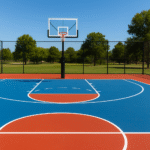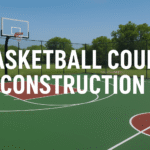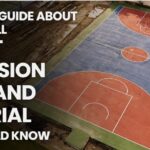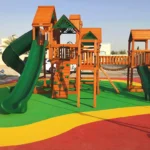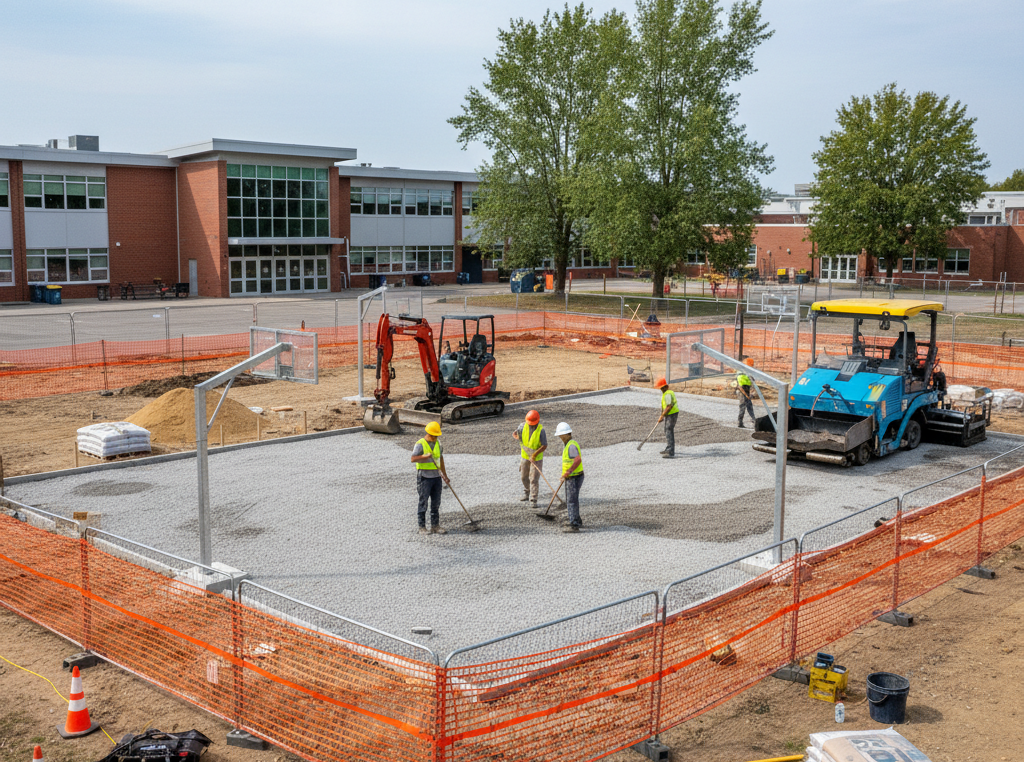Introduction
Sports aren’t just an extracurricular activity anymore—they’re a crucial part of a student’s development. Schools that invest in top-quality school sports court construction are not only enhancing athletic performance but also promoting health, discipline, and school pride.
From basketball courts to volleyball courts, the variety of facilities now being built in educational institutions has increased dramatically. Add in the use of advanced materials like EPDM flooring, and schools are creating safer, more durable, and highly versatile play areas.
So, how do you build a school sports court that checks all the boxes? Let’s walk through the process, from planning to maintenance, and explore how you can create a court that will stand the test of time.
Planning the Perfect Sports Court
Understanding the Needs of the School
Before breaking ground, start by answering some key questions:
- What sports will be played?
- How many students will use the court?
- Is it for physical education classes only or also for tournaments?
Understanding these requirements will guide the type of sports court construction needed—whether it’s a single-use basketball court, a volleyball court, or a multi-sport court.
Choosing the Right Type of Court
Popular options include:
- Basketball court – For schools with a strong basketball program.
- Volleyball court – Ideal for indoor gyms or outdoor setups.
- Multi-purpose courts – A flexible option that accommodates several sports with different markings.
Indoor vs. Outdoor Courts
Indoor courts offer protection from weather, longer lifespan, and are great for year-round use—but they are expensive.
Outdoor courts are more affordable, easier to build, and ideal for schools with open space. Proper surface treatment is crucial to ensure longevity.
Site Selection and Preparation
Site Analysis and Location Considerations
You need a flat, accessible area that’s not prone to flooding or heavy shade. It should also be positioned close to changing rooms and easy for supervision.
Ground Preparation and Leveling
Ground must be leveled and compacted to prevent issues later. A proper sub-base of crushed stone or gravel ensures stability and drainage.
Environmental and Drainage Considerations
Install a drainage system that diverts water away from the surface, especially for outdoor basketball courts or volleyball courts. EPDM surfaces also help due to their porous design, which aids water drainage.
Materials Used in Construction
Court Surface Options
Your choice of surface impacts durability, safety, and player performance:
- Concrete – Durable and cost-effective, but hard on the joints.
- Asphalt – Budget-friendly but requires regular maintenance.
- Acrylic coatings – Provide grip and color but are best for dry climates.
- EPDM Flooring – A modern, rubber-based option that offers high shock absorption, excellent grip, and weather resistance. It’s ideal for both indoor and outdoor sports court construction.
Fencing and Boundary Materials
Chain-link fences are standard. They define boundaries and keep balls within play areas. Consider padding or netting for added safety.
Lighting and Electrical Needs
LED floodlights ensure the court is usable after dark. Install weatherproof electrical conduits and switches to withstand outdoor conditions.
Design and Layout
Standard Court Dimensions and Markings
Make sure the court adheres to standard dimensions:
- Basketball court: 28m x 15m (FIBA standard)
- Volleyball court: 18m x 9m
Accurate line markings in contrasting colors are essential—especially on multi-sport courts.
Multi-sport Court Layouts
Use different colored lines for each sport to avoid confusion. EPDM flooring allows for crisp, long-lasting markings that don’t fade easily.
Accessibility and Safety Design Features
Include ramps, handrails, and clear pathways for disabled students. Add cushioned surfaces like EPDM around posts and high-impact zones.
Construction Process Step-by-Step
1. Excavation and Base Layer
Start by clearing the area. Install a crushed stone base, then compact it for stability. This step forms the foundation for the surface material.
2. Surface Installation
Depending on the court type:
- For concrete/asphalt: Lay and cure the surface.
- For EPDM flooring: A rubber granule mix is poured over a binder layer and leveled for a seamless, cushioned finish.
3. Painting and Line Marking
Use specialized sports-grade paints for markings. For multi-sport use, different color codes for each sport are essential.
4. Equipment and Fixtures
Install posts, nets, hoops, fencing, and lighting. Make sure everything is fixed securely and padded where necessary.
5. Safety Checks
A final inspection ensures surface evenness, proper line markings, and secure equipment. Any defects must be fixed before use.
Cost Considerations
Budget Planning
Include:
- Surface material costs
- Labor
- Equipment
- Lighting
- Maintenance setup
Factors That Influence Costs
- Size of the court
- Type of flooring (EPDM is more expensive but lasts longer)
- Indoor vs. outdoor
- Site preparation needs
Ways to Save Without Cutting Corners
- Combine sports into a single court
- Use recycled EPDM granules
- Work with local contractors to reduce logistics
Maintenance and Longevity
Daily and Weekly Care
- Sweep debris
- Check for cracks or damage
- Wipe down goalposts or nets
Seasonal and Annual Care
- Reseal surfaces (for asphalt/concrete)
- Repaint faded lines
- Inspect drainage systems
EPDM Flooring Maintenance
- Pressure wash quarterly
- Spot repair any damaged rubber
- Clean out surface pores to prevent water blockage
Choosing the Right Contractor
What to Look For
- Experience in school sports court construction
- Positive reviews and case studies
- Certified use of quality materials like EPDM
Questions to Ask
- Do you specialize in basketball and volleyball courts?
- What warranty do you provide?
- What safety certifications do your surfaces meet?
Warranties and Insurance
Don’t overlook this—ensure your contractor is insured and backs their work with warranties on both labor and materials.
Benefits to Students and Schools
Physical and Mental Health
Regular use of basketball or volleyball courts improves cardiovascular health and reduces stress.
Improved Discipline and Team Spirit
Sports teach goal setting, collaboration, and perseverance—skills that translate directly into academic performance.
Boosted School Image
Quality courts attract new students and can even host community events or competitions, enhancing the school’s reputation.
Case Studies: Real School Successes
Public School Transformation
A school in New Jersey installed a multi-sport EPDM court and saw a 30% increase in student participation in physical activities.
Private School Excellence
A private school used EPDM rubber for its indoor basketball court, reducing injury complaints and making the space usable year-round.
Community-Funded Court
A rural school teamed up with the community to fund an outdoor volleyball court—now used for inter-school tournaments.
Common Mistakes to Avoid
1. Skipping the Planning Phase
Rushing into construction without planning sports needs leads to inefficient use of space and budget.
2. Ignoring Local Regulations
Permits, environmental codes, and accessibility laws must be followed to avoid costly delays.
3. Forgetting Long-Term Maintenance
A beautiful court today can become a liability in two years if not maintained.
Future Trends in Sports Court Construction
Smart Surfaces
Some courts now feature sensors that track player movement and performance.
Eco-Friendly Materials
Recycled EPDM flooring and solar-powered lighting are leading the green revolution in school construction.
Modular Court Systems
Pre-fabricated court tiles and portable designs are perfect for schools with limited space or budgets.
Conclusion
Building a school sports court is more than a construction project—it’s an investment in the future of your students. Whether you’re installing a basketball court, a volleyball court, or a multi-sport facility with EPDM flooring, quality planning and expert construction are non-negotiable.
With the right choices, your sports court will serve generations of students—keeping them active, engaged, and inspired.
FAQs
1. What is the best surface for a school sports court?
EPDM flooring is one of the best options due to its durability, safety, and weather resistance.
2. How long does it take to build a sports court?
Most sports court construction projects take between 4–8 weeks, depending on size, materials, and weather.
3. Can a school court be used for multiple sports?
Yes! Multi-sport courts with color-coded lines can be used for basketball, volleyball, tennis, and more.
4. How much does a school sports court cost?
Costs vary based on size and materials. Expect to spend $20,000–$100,000 for a standard court. EPDM options cost more upfront but last longer.
5. How do you maintain a school sports court?
Regular cleaning, seasonal repainting, and surface inspections are key. EPDM flooring requires minimal maintenance and lasts up to 15 years.
